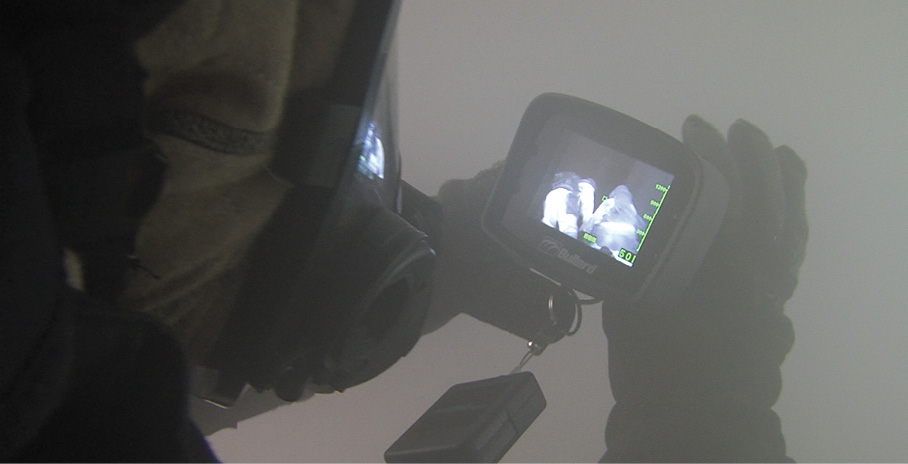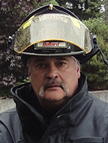
Thermal Imaging in the Volunteer Sector
This month, I’d like to reflect on the volunteer sector of the fire service, which accounts for the majority of firefighters in North America today.

A volunteer defined by Webster’s Dictionary is “a person who voluntarily undertakes or expresses a willingness to undertake a service.” Volunteerism is “the act or practice of doing volunteer work in community service.” Many volunteer firefighters receive no remuneration for their time, while others receive a small yearly stipend for the number of hours they work. Some volunteer fire departments train once a week, others train biweekly, and some only train once a month—yes, that is only 12 times a year. Of course, that assumes that the volunteer firefighter attends all 12 training sessions, taking into consideration his full-time job, vacation, sickness, family matters, etc.

1 Every firefighter must be trained on how to safely and effectively use the TIC. (Photo courtesy of Bullard.)
Some fire departments have a dedicated training officer, while others train on what the chief deems to be essential. A typical training night could consist of vehicle and equipment checks, which can take a while depending on how many apparatus the department has and how many firefighters show up for training that night. Then there’s self-contained breathing apparatus (SCBA) or ladder drill training that evening followed by a meeting. Federal legislation, municipal bylaws, and fire marshals’ directives all say and dictate what a firefighter must be trained on and to what standard or level based on jurisdiction.
From my perspective, I see the volunteer firefighter having to give more and more to stay on as a volunteer serving to protect the community. The requirements and standards as they apply to the fire apparatus, personal protective equipment, and firefighting equipment must be met by the volunteer firefighter to perform his job. Not part of the standard firefighting requirements is the use of operating a thermal imaging camera (TIC). For many fire departments, this valuable tool is considered a luxury. Some chiefs who have fought fires for many years and never used or owned a TIC ask, why do they need one now? Fortunately, society has changed, and so have tactics, and the use of a TIC has made the job safer and to a degree easier. Some departments have municipal budgets; others rely on donations and fundraisers in the community to keep operations going and purchase equipment.
I know of a volunteer fire department where an elderly lady walked into the fire station and asked the firefighters what they could use. The firefighters joked with her and said they could really use a TIC and explained to her what it was and how this tool could help them perform their jobs more efficiently. She asked how much a TIC cost, and the firefighters told her. She pulled out her checkbook and wrote a check for the cost of a TIC. Now, this scenario doesn’t happen every day. The day the TIC arrived, the firefighters looked at each other and said, “What do we do with it”? The chief said, “I’ll be the only who uses it; therefore, I’m the only one who needs to be trained.” WRONG! Everyone needs to be trained on the TIC, and anyone should be able to use it. Remember, this was a volunteer fire department; you never know who is going to show up for training, including the chief.
I’ve compiled a list of helpful hints that can help you learn how to use a TIC. Who knows? Maybe a nice elderly lady will walk into your fire department and buy you one.
Ask your sales representative to explain the basic operations of the TIC, including turning it on/off; charging, changing, and replacing the batteries; the different modes on the TIC; and routine maintenance. All TICs have basic colorization of yellow/orange/red and temperature measurement consisting of a sliding bar scale and/or digital number. Some manufacturers have optional features that can get a bit confusing, so make sure you totally understand what they do.
Ask if the manufacturer has someone who can provide proper training besides the sales representative. If no representative is available, ask for a recommendation of someone who could conduct a TIC training class. It’s critical to have a full understanding of the proper techniques of using a TIC as well as the different applications the TIC can be used for besides firefighting.
Be sure all firefighters are involved in the training and that everyone knows and fully understands image interpretation and how to use it safely and effectively.
Include TIC training in your regular fire department curriculum and use the TIC as often as possible in all training scenarios—SCBA, ladder drills, search and rescue, auto extrication, size-up, and so on. The more you use your TIC, the more proficient you will become.
Once training is complete, be sure to mount the TIC in its powerhouse charger on your apparatus so you have it readily available for your next call. What calls will you use your TIC for? ALL OF THEM! It is a life-saving tool and helps to make you more effective and efficient at your job. Get it off the apparatus and use it!
Once you are comfortable using your TIC, invite your generous donor and the media to the fire station to show off your new valued tool. Don’t forget to post your new donation on social media. Who knows? The coverage you get may just help you secure more donations for other equipment or perhaps another TIC.
During Fire Prevention Week, show your TIC off to the kids and their parents. Take it with you when conducting fire inspections. You will be surprised at what you will see when looking at those electrical panels.
Keep a log of all the responses where you used the TIC. Compare your log from when you started using a TIC to when you didn’t have one, and you will be surprised how much more efficient you are when responding to calls.
Finally, practice, practice, and practice even more on using your TIC.
MANFRED KIHN is a 19-year veteran of the fire service, having served as an ambulance officer, emergency services specialist, firefighter, captain, and fire chief. He has been a member of Bullard’s Emergency Responder team since 2005 and is the company’s fire training specialist for thermal imaging technology. He is certified through the Law Enforcement Thermographers’ Association (LETA) as a thermal imaging instructor and is a recipient of the Ontario Medal for Firefighters Bravery. If you have questions about thermal imaging, you can e-mail him at [email protected].

